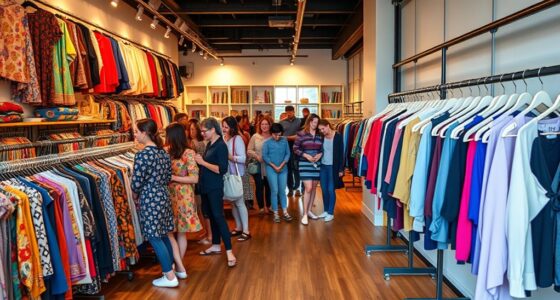Digital fashion and virtual clothing help you reduce physical waste by replacing traditional design and showcase methods with virtual experiences. You can explore and try on clothes virtually, which cuts down on sample production and reduces textile excess. By embracing these innovations, you contribute to a more sustainable industry with less environmental impact. As you learn more, you’ll see how these digital solutions are shaping a greener future for fashion and your choices.
Key Takeaways
- Virtual clothing eliminates the need for physical samples, reducing material waste and resource consumption in fashion production.
- Digital fashion showcases decrease environmental impact by replacing traditional runway shows and minimizing staging waste.
- AR and 3D models enable virtual try-ons, reducing returns and waste from unsold or discarded physical garments.
- Digital fashion promotes sustainability by lowering carbon emissions associated with manufacturing, transportation, and event staging.
- Embracing virtual clothing fosters eco-friendly consumer habits, decreasing waste and supporting resource-conserving industry practices.

Have you ever wondered how technology is transforming the way we express ourselves through fashion? One of the most exciting advancements is the rise of augmented reality (AR), which is changing how designers showcase their collections and how you experience fashion shows. Instead of traditional runway shows that require massive amounts of resources and produce significant waste, virtual runways powered by AR enable brands to present their designs digitally. You can now attend a fashion show from your living room, viewing 3D models of clothing that appear right before your eyes through your smartphone or AR glasses. This shift not only makes fashion more accessible but also drastically reduces the environmental footprint associated with staging physical events.
With augmented reality, you no longer need to produce hundreds of physical samples or set up elaborate stages with lighting and scenery. Designers can create intricate digital garments that are displayed in virtual environments, allowing you to explore every detail without the need for fabric, dyes, or shipping. Virtual runways also mean fewer leftovers from sample production, which often ends up in landfills. These digital presentations help brands reduce their waste and carbon emissions, aligning fashion more closely with sustainability goals. As you engage with these virtual experiences, you’re participating in a movement that prioritizes innovation while minimizing environmental harm.
Virtual fashion reduces waste by replacing physical samples and elaborate staging, promoting sustainability and innovative design.
Furthermore, AR and virtual runways open the door for personalized fashion experiences. You can virtually try on clothing, mix and match styles, and see how different designs look on your own avatar without ever physically trying on garments. This not only cuts down on returns and waste but also empowers you to make more sustainable choices. As digital fashion evolves, you’ll find that virtual clothing and accessories are becoming more detailed and realistic, blurring the line between physical and digital wardrobes. The integration of digital innovation in fashion also encourages brands to adopt more sustainable practices, reducing reliance on traditional manufacturing processes.
The more you embrace these innovations, the more you contribute to reducing the waste associated with traditional fashion production, which often involves excess inventory and discarded garments. In essence, augmented reality and virtual runways are revolutionizing the fashion industry by shifting focus from physical production to digital innovation. They allow brands to showcase their creativity without the environmental costs of traditional fashion shows and sample production. For you, this means more immersive, accessible, and sustainable fashion experiences. By embracing virtual clothing, you’re part of a movement that’s redefining how fashion is designed, displayed, and consumed—one that champions reducing waste, conserving resources, and pushing the industry toward a greener future. As technology continues to advance, your role in supporting sustainable fashion through digital means becomes even more significant.
Frequently Asked Questions
How Secure Are Digital Fashion Files From Hacking?
Digital fashion files are generally quite secure, but they’re still vulnerable to cybersecurity threats. You should guarantee that your files are protected with strong data encryption, which helps prevent unauthorized access. Keep your software updated and use strong passwords to minimize risks. While no system is completely immune, taking these precautions considerably reduces the chances of hacking, so your virtual clothing stays safe and secure.
Can Virtual Clothing Be Customized Easily by Consumers?
Did you know that 78% of consumers prefer customizable products? Virtual clothing allows you to easily customize your outfits to match your style, making it simple to meet your preferences. With user-friendly virtual customization tools, you can try different colors, patterns, and styles instantly. This flexibility enhances your experience, ensuring your digital wardrobe reflects your unique taste without the hassle or waste of physical clothing.
What Are the Environmental Impacts of Manufacturing Virtual Garments?
Manufacturing virtual garments has minimal environmental impact since it doesn’t involve traditional processes like fabric production or chemical use. You help promote sustainable production and resource conservation by choosing digital fashion, which reduces physical waste and lowers energy consumption associated with manufacturing. Virtual clothing’s eco-friendly nature means you contribute to less pollution and waste, making it a responsible way to express your style without harming the planet.
How Do Virtual Clothing Platforms Ensure User Privacy?
You can trust virtual clothing platforms to safeguard your privacy by using robust data encryption, keeping your personal information secure. When customizing your avatar, these platforms guarantee your data stays private and safe. They often implement strict privacy policies and give you control over what info you share. By focusing on secure encryption and user control, they make sure your virtual clothing experience remains confidential and protected.
Will Virtual Fashion Replace Physical Clothing Entirely?
Virtual fashion won’t completely replace physical clothing, but it will transform how you style yourself. Your digital wardrobe allows you to experiment with virtual styling without waste or commitment. You’ll use virtual clothing for social media, gaming, or virtual events, reducing physical waste. While physical clothes will still exist for comfort and practicality, digital fashion offers a sustainable, versatile alternative that complements your wardrobe and enhances your creative expression.
Conclusion
Imagine browsing a digital wardrobe where vibrant, stylish outfits shimmer on your screen, no fabric wasted or landfill cluttered. By embracing virtual clothing, you can effortlessly switch looks without leaving a carbon footprint. Feel the freedom of expressing yourself creatively while helping the planet breathe easier. Digital fashion isn’t just a trend—it’s a colorful, sustainable future waiting for you to explore. Step into this virtual world and wear your values with every click.









